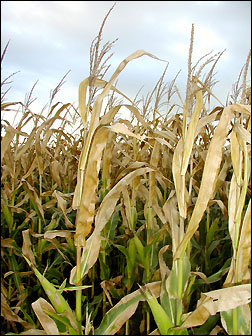August freeze damages corn and soybean crops
Temperatures dropped as low as 28 degrees on Saturday, Aug. 21. Official records from the University of Minnesota Extension Service indicate that frost was the earliest on record.
Unfortunately, it's still unknown just how much damage the August freeze actually caused, according to Phyllis Framstad, the director of the Stearns County office of the Farm Service Agency, but early estimates indicate that the total crop loss in Stearns County could range from very little in the south to near total loss in the north, with the most severe damage north of I-94.
Frost damage isn't always straightforward, said Framstad. Obvious damage to corn and soybean includes dried, dead leaves on the plants, but more subtle damage, - including substantial yield losses in plants that can still produce a crop - won't be determined for some time. In addition, said Framstad, some frost-damaged crops may appear healthy but may simply stop growing. This could take weeks to detect, she added.
 To qualify for federal disaster relief funds in the form of low-interest loans, Stearns County needs to have suffered at least a 30 percent crop loss, said Framstad. Otherwise, most crop insurance programs can help farmers absorb any weather-related income loss, she added.
To qualify for federal disaster relief funds in the form of low-interest loans, Stearns County needs to have suffered at least a 30 percent crop loss, said Framstad. Otherwise, most crop insurance programs can help farmers absorb any weather-related income loss, she added.
Last month's early freeze caused sporadic damage to crops throughout the area. Crops on low, sandy ground, like this corn, suffered more damage than crops on higher, heavier ground.
With widespread frost reported as far south as Mankato, local farmers may have fared better than their neighbors to the north as the frost was spotty and affected primarily low-lying crops in the Paynesville area. Crops that were already stressed by the unusual weather this summer were more susceptible to frost damage, according to Dave Schwartz of the Kandiyohi County Extension Office.
Herbert Koetter, who farms near Roscoe, suffered what is probably a total loss in some of his corn fields but he doesn't know yet what will happen to his frozen soybeans. At first glance, only the upper leaves were frozen, but he still isn't sure if the stems were frozen or not.
Donald Lieser will probably take a total crop loss in his fields just north Roscoe, he said. The corn there was already stressed from drought and cold and was drying out from the bottom up. Frost damage destroyed the stalks from the top down, finishing off the crop, he said.
On the other hand, Ken Schefers, who farms just down the road from Koetter, had virtually no frost damage, he said. And Lieser had another field just a few miles away that had very little damage and might still be able to produce a crop, if the weather cooperates.
It was pretty hit-and-miss all over the area, agreed John VanderBeek of the Paynesville Farmer's Union. Crops on heavy soil or in high fields were unscathed by the frost while crops in low, sandy areas (near Hawick and Roscoe for example) suffered more extensive damage.
Frost damage was just another blow to area farmers who had already suffered from unusual weather this year, according to Dan Martens of the Stearns County Extension Office.
Lieser thinks the weather has been crazy. His crops have suffered from unusually cool, dry weather all season, and to add insult to injury, one of his barns was damaged by a freak windstorm in July, he said.
Because of cool weather and sporadic rainfall for much of the summer, crops throughout the state, including those in this area, were already two to four weeks behind schedule. During a normal growing season, corn and soybean crops might have been far enough along that an August frost wouldn't greatly reduce yields. As it stands, however, most crops are still too immature to even consider harvesting for silage, said Martens.
Area farmers need at least a month of warm, sunny weather to salvage what is left of the crop, said Martens. Currently, however, the forecast is for a cool September, he added.
Lieser figures he needs at least six weeks of 80-degree weather to bring his corn and beans to maturity.
Farming is funny, said Koetter. The same cool weather that has damaged his corn and soybeans helped make a beautiful oat crop, he said. "You can't do nothing about the weather," said Koetter. "I've learned to be satisfied with what I get," he added.
Contact the author at editor@paynesvillepress.com • Return to News Menu
Home | Marketplace | Community